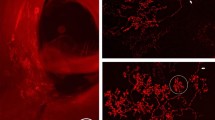Summary
Single-unit vagal afferent recordings were made on 55 intrapulmonary receptors in 15 anesthetized or decerebrate bullfrogs. Intrapulmonary CO2 concentration and intrapulmonary pressure were controlled independently by unidirectionally ventilating the lungs. No CO2 receptors (insensitive to stretch of the lung) of the kind reported in birds and reptiles were found; all 55 receptors were mechano-sensitive. Of these mechanoreceptors, 39 adapted slowly to inflation of the lung and 16 adapted rapidly. Thirtythree of the slowly-adapting receptors and 15 of the rapidly adapting receptors decreased their discharge frequency as intrapulmonary CO2 concentration was increased. Inflating the lung enhanced CO2 sensitivity. The results indicate that the frog possesses CO2-sensitive pulmonary mechanoreceptors similar to those of mammals and reptiles.
Similar content being viewed by others
Abbreviations
- P ip :
-
intrapulmonary pressure
- \(F_{I CO_2 }\) :
-
fractional inspired concentration of CO2
References
Bartlett, D., Jr., Sant'Ambrogio, G.: Effects of local and systemic hypercapnia on the discharge of stretch receptors in the airways of the dog. Resp. Physiol.26, 91–99 (1976)
Bartoli, A., Cross, B.A., Guz, A., Jain, S.K., Noble, M.I.M., Trenchard, D.W.: The effect of carbon dioxide in the airways and alveoli on ventilation; a vagal reflex studied in the dog. J. Physiol. (Lond.)240, 91–109 (1974)
Bradley, G.W., Noble, M.I.M., Trenchard, D.: The direct effect on pulmonary stretch receptor discharge produced by changing lung carbon dioxide concentration in dogs on cardiopulmonary bypass and its action on breathing. J. Physiol. (Lond.)261, 359–373 (1976)
Burger, R.E.: Pulmonary chemosensitivity in the domestic fowl. Fed. Proc.27, 328 (1968)
Burger, R.E., Osborne, J.L., Banzett, R.B.: Intrapulmonary chemoreceptors inGallus domesticus: Adequate stimulus and functional localization. Resp. Physiol.22, 87–97 (1974)
Fedde, M.R., Gatz, R.N., Slama, H., Scheid, P.: Intrapulmonary CO2 receptors in the duck: I. Stimulus specificity. Resp. Physiol.22, 99–114 (1974)
Fedde, M.R., Kuhlmann, W.D., Scheid, P.: Intrapulmonary receptors in the Tegu lizard: I. Sensitivity to CO2. Resp. Physiol.29, 35–48 (1977)
Gatz, R.N., Fedde, M.R., Crawford, E.C., Jr.: Lizard Lungs: CO2-sensitive receptors inTupinambis nigropunctatus. Experientia31, 455–456 (1975)
Guz, A., Noble, M.I.M., Widdicombe, J.G., Trenchard, D., Mushin, W.W.: The effect of bilateral block of vagus and glossopharyngeal nerves on the ventilatory response to CO2 of conscious man. Resp. Physiol.1, 206–210 (1966)
Kunz, A.L., Kawashiro, T., Scheid, P.: Study of CO2 sensitive vagal afferents in the cat lung. Resp. Physiol.27, 347–355 (1976)
McKean, T.A.: A linear approximation of the transfer function of pulmonary mechanoreceptors of the frog. J. Appl. Physiol.27, 775–781 (1969)
Milsom, W.K., Jones, D.R.: Are reptilian pulmonary receptors mechano- or chemosensitive? Nature261, 327–328 (1976)
Mustafa, M.E.K.Y., Purves, M.J.: The effect of CO2 upon discharge from slowly adapting stretch receptors in the lungs of rabbits. Resp. Physiol.16, 197–212 (1972)
Osborne, J.L., Mitchell, G.S.: Regulation of arterial PCO2 during inhalation of CO2 in chickens. Resp. Physiol.31, 357–364 (1977)
Sampson, S.R., Vidruk, E.H.: Properties of ‘irritant’ receptors in canine lung. Resp. Physiol.25, 9–22 (1975)
Sant'Ambrogio, G., Miserocchi, G., Mortola, J.: Transient responses of pulmonary stretch receptors in the dog to inhalation of carbon dioxide. Resp. Physiol.22, 191–197 (1974)
Schoener, E.P., Frankel, H.M.: Effect of hyperthermia and\(Pa_{CO_2 }\) on the slowly adapting pulmonary stretch receptor. Am. J. Physiol.222, 68–72 (1972)
Smyth, D.H.: The central and reflex control of respiration in the frog. J. Physiol. (Lond.)95, 305–327 (1939)
Taglietti, V., Casella, C.: Stretch receptors stimulation in frog's lungs. Pflügers Arch.292, 297–308 (1966)
Author information
Authors and Affiliations
Additional information
The authors wish to thank Dalyn Wilson for his help in gathering the experimental animals and for his technical assistance. The study was supported in part by a grant-in-aid from the American Heart Association, Kansas Affiliate, Inc. Contribution No. 78-185-J Department of Anatomy and Physiology, KAES, Kansas State University, Manhattan, Kansas 66506, USA.
Rights and permissions
About this article
Cite this article
Kuhlmann, W.D., Fedde, M.R. Intrapulmonary receptors in the bullfrog: Sensitivity to CO2 . J. Comp. Physiol. 132, 69–75 (1979). https://doi.org/10.1007/BF00617733
Accepted:
Issue Date:
DOI: https://doi.org/10.1007/BF00617733




